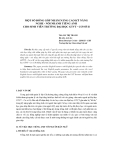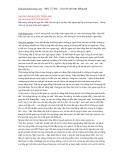
T.T.Minh Giang, N.T.To Uyen / Tạp chí Khoa học và Công nghệ Đại học Duy Tân 05(66) (2024) 137-147
137
A study of connected speech in English songs
Nghiên cứu hiện tượng nối âm trong các bài hát tiếng Anh
Tran Thi Minh Gianga*, Nguyen Thi To Uyena
Trần Thị Minh Gianga*, Nguyễn Thị Tố Uyêna
aFaculty of English, School of Languages, Humanities and Social Sciences, Duy Tan University, Da Nang, 550000,
Vietnam
aKhoa Tiếng Anh, Trường Ngôn ngữ - Xã hội Nhân văn, Trường Ðại học Duy Tân, Ðà Nẵng, Việt Nam
(Date of receiving article: 02/05/2024, date of completion of review: 13/05/2024, date of acceptance for posting:
21/05/2024)
Abstract
The phenomena of assimilation, elision, and linking are complex features but play a significant role in understanding and
developing learners' English listening and pronunciation skills. The study was conducted to help English-majored students
practice and improve the use of the sound connection phenomenon in their English listening and speaking skills by listening
to English songs. Therefore, the research objectives are to analyze the differences in the occurrence percentages of sound
connection phenomena in 100 songs and to evaluate the English-majored students' ability to distinguish types of connected
speech in songs. Additionally, the research methods used in this article include information collection, quantitative, and
experimental methods. In addition, research data focus on three kinds of sound connection phenomena in 100 English songs
and 20 sound connection recognition analyses of English-majored students participating in a Phonetics-Phonology class,
course K27 at Duy Tan University. Lastly, the research results show a significant difference between the present rates of
each type of connected speech in 100 songs and the English-majored students' ability to identify basic types of sound
connections; however, there are still some limitations in analyzing the more complicated phenomena.
Keywords: connected speech; assimilation; elision; linking; English songs.
Tóm tắt
Hiện tượng đồng hóa, mất âm và nối âm là những đặc điểm âm thanh phức tạp nhưng đóng vai trò quan trọng trong việc
hiểu và phát triển kỹ năng nghe, phát âm tiếng Anh của người học. Bài nghiên cứu này được thực hiện nhằm giúp các bạn
sinh viên chuyên ngành tiếng Anh có thể rèn luyện và nâng cao việc sử dụng hiện tượng nối âm trong kỹ năng nghe và
nói tiếng Anh thông qua việc nghe các bài hát Anh ngữ. Vì vậy, mục tiêu của bài nghiên cứu này là phân tích sự khác biệt
về tỷ lệ xuất hiện của các hiện tượng nối âm trong 100 bài hát và đánh giá khả năng phân biệt các loại liên kết âm trong
bài nhạc của sinh viên chuyên ngành tiếng Anh. Phương pháp nghiên cứu được sử dụng trong bài báo này bao gồm
phương pháp thu thập thông tin, phương pháp định lượng và phương pháp thực nghiệm. Ngoài ra, dữ liệu nghiên cứu tập
trung vào ba loại hiện tượng nối âm trong 100 bài hát Anh ngữ và 20 bài phân tích nhận dạng liên kết âm của các bạn
sinh viên chuyên ngành tiếng Anh đang tham gia một lớp Ngữ âm-Âm vị học, khóa 27, Trường Đại học Duy Tân. Cuối
cùng, kết quả nghiên cứu cho thấy sự khác biệt đáng kể giữa tỷ lệ hiện diện của từng loại nối âm trong 100 bài nhạc và
sinh viên có khả năng nhận biết các hiện tượng nối âm cơ bản. Tuy nhiên, các bạn vẫn còn một số hạn chế trong việc
phân tích các hiện tượng phức tạp hơn.
Từ khóa: hiện tượng nối âm; đồng hóa âm; nuốt âm; nối âm; các bài hát tiếng Anh.
*Corresponding author: Tran Thi Minh Giang
Email: trantminhgiang@duytan.edu.vn
05(66) (2024) 137-147
DTU Journal of Science and Technology















